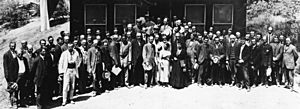Henry Norris Russell facts for kids
Quick facts for kids
Henry Norris Russell
|
|
|---|---|
 |
|
| Born | October 25, 1877 Oyster Bay, New York, U.S.
|
| Died | February 18, 1957 (aged 79) Princeton, New Jersey, U.S.
|
| Alma mater | Princeton University |
| Known for |
|
| Awards |
|
| Scientific career | |
| Fields | Astronomy |
| Institutions | Princeton University |
| Doctoral advisor | Charles Augustus Young |
| Doctoral students |
|
| Influences |
|
| Influenced | Charlotte Moore Sitterly |
Henry Norris Russell (October 25, 1877 – February 18, 1957) was an important American astronomer. He is famous for working with Ejnar Hertzsprung to create the Hertzsprung–Russell diagram in 1910. This special diagram helps scientists understand stars better.
Russell also played a key role in understanding the chemical makeup of the Sun. He helped confirm the groundbreaking work of Cecilia Payne-Gaposchkin, who first discovered that the Sun's composition was different from Earth's. In 1923, he worked with Frederick Albert Saunders to develop something called Russell–Saunders coupling, also known as LS coupling, which helps explain how atoms behave.
Contents
Early Life and Education
Henry Norris Russell was born on October 25, 1877, in Oyster Bay (town), New York. His father was Rev Alexander Gatherer Russell, and his mother was Eliza Hoxie Norris.
After finishing school at George School in 1895, he went to Princeton University. He studied astronomy there and earned his first degree in 1897. He then completed his doctorate degree in 1899, studying under a professor named Charles Augustus Young.
Working at Cambridge Observatory
From 1903 to 1905, Russell worked at the Cambridge Observatory in England. He was a research assistant for the Carnegie Institution for Science. During this time, he worked with Arthur Robert Hinks and was greatly influenced by another scientist, George Darwin.
Career at Princeton University
After his time in England, Russell returned to Princeton University. He started as an instructor in astronomy in 1905. He then became an assistant professor in 1908 and a full professor in 1911.
From 1912 to 1947, he was the director of the Princeton University Observatory. During these years, a talented astronomer named Charlotte Moore Sitterly worked with him. She helped him measure and figure out many things about stars. Russell continued his research at Princeton until 1947.
He passed away in Princeton, New Jersey, on February 18, 1957, when he was 79 years old. He is buried in Princeton Cemetery.

Family Life
In November 1908, Henry Norris Russell married Lucy May Cole. They had four children together. Their youngest daughter, Margaret Russell, who was born in 1914, later married another astronomer named Frank K. Edmondson in the 1930s.
Important Discoveries and Books
Henry Norris Russell made many important contributions to astronomy. One of his most famous works was a two-volume textbook he co-wrote.
The Astronomy Textbook
In 1927, Russell worked with Raymond Smith Dugan and John Quincy Stewart to write an important textbook called Astronomy: A Revision of Young’s Manual of Astronomy. This book became the main textbook for astronomy students for about 20 years.
The textbook had two parts:
- The first volume was about The Solar System.
- The second volume was about Astrophysics and Stellar Astronomy.
This textbook helped make popular the idea that a star's features, like its size, temperature, and brightness, are mostly decided by how much mass it has and what chemicals it's made of. This idea is now known as the Vogt–Russell theorem. Because a star's chemical makeup slowly changes over time, this also leads to how stars change and evolve.
Understanding the Sun's Composition
Russell also played a big part in understanding what the Sun is made of. A scientist named Cecilia Payne-Gaposchkin had discovered in her research that the Sun's chemical makeup was different from Earth's. At first, Russell disagreed with her findings because they were different from what was commonly believed at the time.
However, four years later, Russell came to the same conclusion using his own methods. He then made sure to give Cecilia Payne full credit for her original discovery that the Sun has a different chemical composition than Earth. This showed his scientific honesty.
Awards and Honors
Henry Norris Russell received many awards and honors for his important work in astronomy:
- He became a Fellow of the American Academy of Arts and Sciences in 1921.
- He won the Gold Medal of the Royal Astronomical Society in 1921.
- He received the Henry Draper Medal from the National Academy of Sciences in 1922.
- He was awarded the Bruce Medal in 1925.
- He won the Franklin Medal in 1934.
- He became a Foreign Member of the Royal Society in 1937.
- The Henry Norris Russell Lectureship was named after him in 1946.
- An asteroid was named 1762 Russell in his honor.
See also
 In Spanish: Henry Norris Russell para niños
In Spanish: Henry Norris Russell para niños

